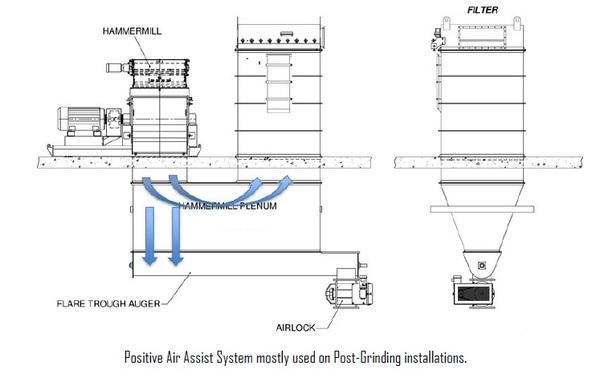The impact of Post-Grinding process on Extruded Feed
Published: September 27, 2018
By: Agro Engineer Zootechnist. Product Line Manager Vegetable Oil & Animal Feed Divisions

Post-grinding can be defined as the grinding step after all the ingredients of the feed are mixed just before the mash enter the pre-conditioner for steam/water
injection. It has been done initially on the Pet Food and Aquafeed industries but now it has become more common with livestock feeds every year.
injection. It has been done initially on the Pet Food and Aquafeed industries but now it has become more common with livestock feeds every year.
Post-grinding process starts with the preparation of the ingredients for mixing (most will have been pre-ground before dosage). In case of grains/cereals, the pregrinding step is made through larger screens so the kernels can be broken into an average of 4 or 5 pieces. These will act as marbles in the grinding chamber of the hammermill to help knock finer particles through the screen and increase productivity of the post-grinding hammermill.
Dosage, weigh and mix the entire ration including micro-ingredients such as premix (vitamins and minerals), antioxidants, antibiotics, essential amino-acids (Llysine
and DL-Methionine) and up to 2% of fat/oil and convey this mixture (mash) to a surge bin above the post-grinding hammermill. There is no need to install a screener between the ribbon mixer and the post-grinding hammermill. Now grind the entire ration and deposit it into the surge bin over the extruder’s pre-conditioner.
and DL-Methionine) and up to 2% of fat/oil and convey this mixture (mash) to a surge bin above the post-grinding hammermill. There is no need to install a screener between the ribbon mixer and the post-grinding hammermill. Now grind the entire ration and deposit it into the surge bin over the extruder’s pre-conditioner.

The post-grinding hammermill should have adequate screen area per horsepower to process the entire ration without raising the temperature of the mash more than 10ºF during the grinding process. A positive or negative air assist system must be installed along with the hammermill to pull the material through the grinding
chamber as fast as possible in order to keep the temperature down and to relief pressure inside the hammermill.
chamber as fast as possible in order to keep the temperature down and to relief pressure inside the hammermill.

The post-grinding hammermill is supplied with a rotary pocket feeder that is capable of conveying the required cubic feet per rotation of mash to the hammermill that is no wider than the grinding chamber. This feeder works with a variable frequency drive to allow the hammermill motor to operate at maximum load by controlling the flow of the material entering the grinding chamber.
One of the most important benefits of the post-grinding step is that uniform grinding of the mash allows to maintain approximately 20ºF higher meal temperature, therefore a better starch gelatinization (due to a better heat transfer from the steam to the particles), increase extruder’s capacity (meaning more pounds
processed per horsepower/hour), less die insert plugging and better product shape at the extruder discharge.
processed per horsepower/hour), less die insert plugging and better product shape at the extruder discharge.
Related topics
Authors:
Join to be able to comment.
Once you join Engormix, you will be able to participate in all content and forums.
* Required information
Would you like to discuss another topic? Create a new post to engage with experts in the community.
Create a postGodrej Agrovet
3 de noviembre de 2018
Steam condioning, improvement in productivity and Gelatonozation are to be proved with comparable data








.jpg&w=3840&q=75)